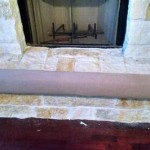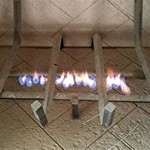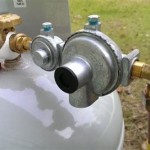Gas Fireplace Dimensions: A Comprehensive Guide to Standards and Considerations
Gas fireplaces have become increasingly popular as a convenient and aesthetically pleasing alternative to traditional wood-burning fireplaces. They offer several advantages, including ease of use, consistent heat output, and cleaner operation. However, before installing a gas fireplace, understanding the common dimensions and the various factors that influence those dimensions is crucial. This article explores standard gas fireplace dimensions, offering a comprehensive guide to help homeowners, contractors, and designers make informed decisions.
The dimensions of a gas fireplace are not universally fixed. They are contingent upon several factors, including the type of fireplace, the desired heating capacity, the aesthetic preferences of the owner, and the structural limitations of the installation site. A thorough understanding of these elements is essential for selecting a gas fireplace that meets both functional and design requirements.
Understanding Common Gas Fireplace Types and Their Dimensional Ranges
Gas fireplaces are available in several distinct types, each with its own typical dimensional range. These types include direct vent fireplaces, vent-free fireplaces, and B-vent fireplaces. Each type has unique venting requirements and installation considerations, directly impacting overall dimensions.
Direct Vent Fireplaces: Direct vent fireplaces are the most common type of gas fireplace. They draw combustion air from outside the home and vent exhaust gases directly to the exterior through a sealed system. This design allows for greater installation flexibility as they can be vented horizontally or vertically. The dimensions of direct vent fireplaces can vary significantly, but typical widths range from 24 inches to 60 inches, with depths typically ranging from 16 inches to 24 inches. The height can also vary, often falling between 24 inches and 48 inches, depending on the specific model and design. The firebox itself contributes significantly to these measurements, with larger fireboxes generally offering a more substantial flame display and greater heat output. When considering direct vent options, the venting system's added footprint should also be accounted for.
Vent-Free Fireplaces: Vent-free, or ventless, gas fireplaces are designed to operate without an external venting system. They burn gas very efficiently, producing minimal byproducts that are released directly into the room. Because they don't require venting, installation is simplified and placement possibilities are expanded. Vent-free fireplaces are generally smaller than direct vent models, with widths typically ranging from 20 inches to 40 inches, depths ranging from 12 inches to 18 inches, and heights ranging from 20 inches to 36 inches. However, building codes in some jurisdictions restrict or prohibit the use of vent-free fireplaces due to concerns about indoor air quality. It is crucial to verify local regulations before considering a vent-free option. The absence of venting also allows for a shallower firebox, contributing to a smaller footprint overall.
B-Vent Fireplaces: B-vent fireplaces utilize a natural draft to vent exhaust gases through a vertical chimney. They rely on indoor air for combustion. B-vent fireplaces are less common in new construction due to their lower energy efficiency compared to direct vent models. Regarding dimensions, B-vent fireplaces are generally similar in size to direct vent fireplaces, with widths ranging from 24 inches to 60 inches, depths ranging from 16 inches to 24 inches, and heights ranging from 24 inches to 48 inches. However, the presence of a chimney or flue adds another layer of consideration to the overall space requirements.
Key Dimensional Factors Influencing Gas Fireplace Selection
Several factors influence the dimensions of the gas fireplace selected for a particular space. These include the desired heating capacity, the aesthetic design, and the structural limitations of the installation site. Understanding these factors allows for a more informed decision-making process.
Heating Capacity (BTU Output): The heating capacity of a gas fireplace is measured in British Thermal Units (BTUs). A higher BTU rating indicates a greater heat output. Larger spaces typically require fireplaces with higher BTU ratings to effectively heat the area. Consequently, fireplaces with higher BTU outputs generally have larger dimensions. For instance, a fireplace intended to heat a large living room might have a width of 48 inches or more, while a fireplace designed for a smaller bedroom might have a width of only 24 inches. Matching the fireplace's BTU output to the room's size ensures efficient heating and avoids overheating or underheating the space. Insufficient fireplace dimensions for desired BTU output result in an ineffective and potentially energy-wasting heating solution.
Aesthetic Design and Style: The aesthetic design and style of a gas fireplace also significantly influence its dimensions. Modern, linear fireplaces tend to be wider and shallower than traditional, more ornate models. Corner fireplaces, designed to fit into the corner of a room, have unique dimensions that must be carefully considered. The choice of the fireplace surround, mantle, and other decorative elements will also affect the overall dimensions and appearance of the unit. For instance, a fireplace with a large stone surround will require additional space compared to a fireplace with a simple wooden mantle. The desired aesthetic – whether contemporary, traditional, or rustic – should be factored into the dimensional considerations early in the planning process.
Structural Limitations and Installation Requirements: The structural limitations of the installation site are a critical factor in determining the appropriate gas fireplace dimensions. Existing walls, framing, and venting pathways can restrict the size and type of fireplace that can be installed. For example, a homeowner renovating an existing fireplace might be limited by the size of the existing firebox opening. In new construction, the location of studs, joists, and other structural elements must be considered to ensure that the fireplace can be safely and properly installed. Additionally, venting requirements specific to the selected fireplace type will affect the placement and, consequently, the dimensions of the overall installation. A thorough assessment of the structural constraints is essential to avoid costly modifications or the selection of an unsuitable fireplace.
Measuring and Planning for Gas Fireplace Installation
Accurate measurement and careful planning are essential for a successful gas fireplace installation. This involves measuring the available space, considering code requirements, and accounting for clearances to combustible materials.
Measuring the Available Space: Before selecting a gas fireplace, accurately measure the available space where the fireplace will be installed. This includes the width, height, and depth of the opening, as well as the surrounding area. Consider any obstructions, such as windows, doors, or electrical outlets. Ensure there is adequate space for the fireplace itself, as well as any necessary clearances for safe operation. Create a detailed diagram or sketch of the space, noting all relevant dimensions and obstructions. This diagram will be invaluable when selecting a fireplace and planning the installation.
Understanding Code Requirements and Clearances: Gas fireplace installations are subject to local building codes and manufacturer's specifications. These codes typically address issues such as venting, gas line connections, and clearances to combustible materials. Clearances to combustible materials are critical for preventing fires. These clearances specify the minimum distance that the fireplace must be from walls, ceilings, and other flammable items. The manufacturer's instructions will provide specific clearance requirements for each model. Always consult with local building officials and qualified installers to ensure that the installation complies with all applicable codes and regulations. Ignoring code requirements can result in safety hazards and legal issues.
Planning for Venting and Gas Line Connections: The venting system and gas line connections are critical components of a gas fireplace installation. For direct vent and B-vent fireplaces, the venting system must be properly sized and installed to ensure safe and efficient removal of exhaust gases. The gas line must be appropriately sized and connected to the fireplace according to local codes and manufacturer's instructions. It is highly recommended to hire a qualified and licensed gas fitter to handle the gas line connections. Improper gas line connections can result in gas leaks, which can be extremely dangerous. Carefully plan the routing of the venting and gas lines to minimize obstructions and ensure easy access for maintenance and repairs.
In summary, selecting the appropriate gas fireplace dimensions requires a thorough understanding of the different fireplace types, the influencing factors such as heating capacity and structural limitations, and the importance of accurate measurement and planning. By carefully considering these elements, homeowners and professionals can ensure a safe, efficient, and aesthetically pleasing gas fireplace installation.

The Proper Way To Measure Dimensions Of A Fireplace

616 Deluxe Ember Glo Made In America Fireplace Xtrordinair

The Langley Gas Fireplace 36l Shallow Linear

Napoleon Gdi44 Gas Insert Fireplacepro Fireplace Dimensions Vented

Lopi Radiant Plus Medium Greensmart Basic Gas Fireplace Insert Hearth Appliances

Soliftec Bs1251 Fireplaces
Lopi 864 Clean Face 40k Gs2 Fireplace Fireplaces

Gas Fireplace Insert How To Choose For The French Country Mantel

Lopi Stoves 34 Dvl Gas Fireplace Insert Don S Stove

Lopi 430 Gas Fireplace Insert Hearth And Home Distributors Of Utah Llc
Related Posts








